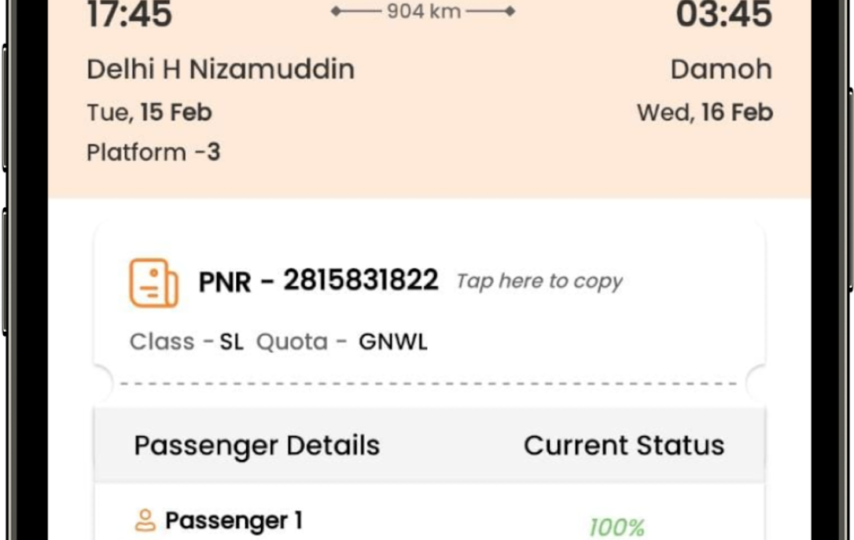Have you ever got tired of waiting for long hours to know the basic info about your train tickets? Have you ever missed your journey for being unsure about the condition of your travel tickets? From now on don’t worry, In this technological age, accessing details about the pnr is more straightforward than ever. By doing merely a small task, we can easily view the complete info related to your ticket. However, anyone might question if it is genuinely secure
Your info with someone online. What if private info is used unlawfully? In this article, let’s discuss what pqwl is. Pqwl means in train ticket & all pertinent info related to verifying your status & exploring secure ways.
What is PNR? How to know PNR status?
PNR, which is an acronym for “Passenger Name
Record” in the Indian Railways, is a unique ten-digit identifier generated by the computerized booking system of the Indian Railways at the time of booking a train ticket. The PNR number contains essential details related to the traveler and their journey, such as the passenger’s title, age, sex, train ID, type of travel, bed preference, and departure and arrival stations.
The PNR acts as a distinct reference number for the passenger’s journey and is used to check the status of the reservation. Travelers can confirm their current booking status by utilizing the PNR number, which helps them determine the seat or bed number, train departure time, and any updates in the schedule.
There are numerous methods for verifying the PNR status of a reservation with the Indian Railways. One can either access the website or download the mobile application, input the PNR number and obtain the latest reservation status. Another option is to send a text message with the PNR number to a specific number provided by the Indian Railways and receive the status update through SMS. Additionally, some booking centers and travel agents also provide PNR status updates to passengers.
The most significant application of the PNR number is to check the present status of the reservation, particularly for tickets with waitlisted or RAC (Reservation Against Cancellation). Passengers with waitlisted or RAC reservations can use the PNR number to ascertain if their ticket has been confirmed or if they have been assigned a seat or bed.
Codes you need to know about the Indian Railway system
Here’s a brief explanation of each railway code you need to know:
RAC ( Reservation Against Cancellation )
RAC, which is an abbreviation for “Reservation Against Cancellation” in the Indian Railways, is a type of booking preference that enables travelers to journey on the train even if their ticket is not confirmed. RAC is an intermediate status between a confirmed ticket and a waitlisted ticket.
The booking status of a ticket can be confirmed, waitlisted, or RAC (Reservation Against Cancellation). If the booking status is “CNF,” it indicates that the ticket has been confirmed, and the traveler has been assigned a seat or berth on the train. A confirmed ticket is guaranteed, and the traveler can board the train without any hassle.
Passengers can verify the status of their ticket by entering the 10-digit PNR number on the Indian Railways website or mobile application. The PNR status will display whether the ticket is confirmed, waitlisted, or RAC.
CAN ( Canceled )
CAN, which is an abbreviation used by Indian Railways that denotes “Canceled.” When a voyager cancels their train ticket, the booking status of the ticket transforms from confirmed, waitlisted, or RAC to “CAN”.
Passengers can also authenticate the status of their canceled ticket by inputting the 10-digit PNR number on the Indian Railways website or mobile application. The PNR status will indicate that the ticket has been canceled.
WL ( Waitlist )
WL is an initialism employed by Indian Railways which means “Waitlist.” When a traveler books a train pass, but all the seats or berths are already taken, the booking status of the pass is Waitlist.
Travelers can analyze the status of their pass by inserting the 10-digit PNR number on the Indian Railways website or mobile application. The PNR status will showcase whether the pass is confirmed, waitlisted, or RAC.
GNWL ( General Waitlist )
GNWL is an acronym that stands for “General Waitlist” in the Indian Railways. It is a kind of waitlist particular to the general quota of seats accessible on a train.
Passengers can check the status of their GNWL ticket by entering the 10-digit PNR number on the Indian Railways website or mobile application. The PNR status will unveil the waitlist number assigned to the ticket, and it will be updated as and when the status of the ticket changes.
TQWL ( Tatkal Quota Waitlist )
TQWL means “Tatkal Quota Waitlist” in the Indian Railways. It is a type of waitlist that is specific to the Tatkal quota of seats available on a train.
Tatkal is a type of reservation that allows passengers to book train tickets at short notice with an additional fee. If a passenger books a Tatkal ticket, and all the available seats are already reserved, the booking status of the ticket is TQWL. The waitlist number given to a TQWL ticket is generally more significant than the waitlist number assigned to a ticket booked under the general quota.
Passengers can check the status of their TQWL ticket by entering the 10-digit PNR number on the Indian Railways website or mobile application. The PNR status will show the waitlist number assigned to the ticket, and it will be updated as and when the status of the ticket changes.
What pqwl is: Pqwl means in train ticket( Pooled Quota Waitlist )
In the realm of Indian Railways, PQWL means pooled quota waitlist or Combined Share Anticipating List is a type of awaiting list for reserved railway tickets. It is a mechanism used to assign seats to commuters who are journeying to the same endpoint but are boarding the train from diverse locations.
The frequently asked question about PQWL is what is meant by pqwl in a train ticket? It is a minor waiting list and is employed for passengers who are journeying shorter ranges than those on the regular waiting list. The tickets under this allocation are generally assigned to passengers who are traveling in a crowd or to those who have picked the inferior berth.
The chances of ratification of PQWL tickets are normally less than those of the regular waiting list, as the number of seats in the combined quota is restricted. The waiting list is cleared in line with the precedence of the passengers, which is determined by the distance of their opening point from the endpoint station.
RLWL ( Remote Location Waitlist )
RLWL means “Remote Location Waitlist” in the Indian Railways. It is a type of waitlist that applies to passengers who begin their journey from a non-origin or non-terminus station.
Passengers can check the status of their RLWL ticket by entering the 10-digit PNR number on the Indian Railways website or mobile application. The PNR status will show the waitlist number assigned to the ticket, and it will be updated as and when the status of the ticket changes.
RSWL ( Roadside Station Waitlist )
RSWL indicates “Road Side Station Waitlist” in the Indian Railways. It is a sort of waitlist that refers to passengers who begin their journey from a roadside station, which is a smaller station that usually has limited facilities.
Passengers can confirm the status of their RSWL ticket by entering the 10-digit PNR number on the Indian Railways website or mobile application. The PNR status will demonstrate the waitlist number allocated to the ticket, and it will be updated as and when the status of the ticket changes.
Conclusion
In conclusion, Here we have deeply explained about the Indian Railway codes that you need to know for the purpose of checking your PNR status & seats availability. We’ve answered the questions that are : what is meant by pqwl? What is meant by pqwl in train tickets? What does TQWL mean? & What is meant by RLWL?








